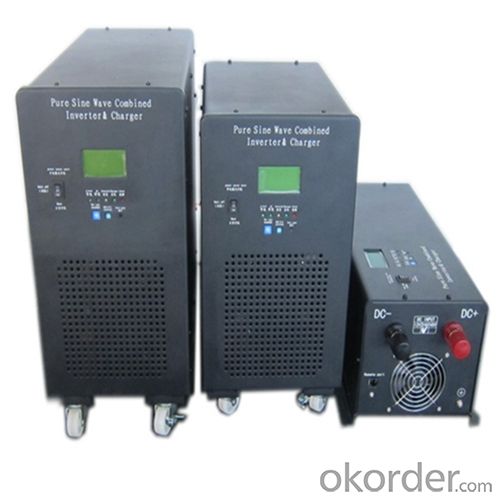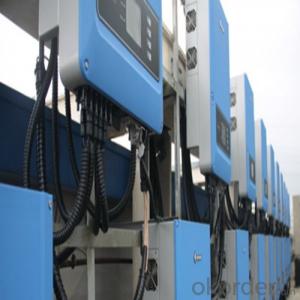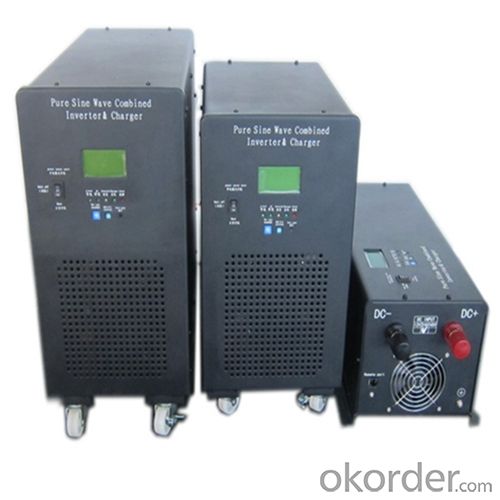Mobile Solar Inverter MPPT Approved Solar Power Inverter
- Loading Port:
- Shanghai
- Payment Terms:
- TT OR LC
- Min Order Qty:
- 6 pc
- Supply Capability:
- 3000 pc/month
OKorder Service Pledge
OKorder Financial Service
You Might Also Like
Performance Characteristics
· 1. Suitable for all electrical equipments
· 2. Large LCD display for more detailed content
· 3. CPU controlled; fast transfer time
· 4. Intelligent battery management, prolonging the service life of the battery
· 5. Complete protection function, high reliability
· 6. Can provide high current charge
· 7. Can match different types of batteries
· 8. Disassembled LCD box which can make the operation in a distance of 15 meters
Product introduction
EP series is sine wave low frequency inverter, which is specifically designed for home appliances. It is equipped with a big LCD screen so all information is displayed in detail, which makes it more convenient to use. Charging current of the inverter is adjustable from 5A to 45A and you can also select different charging voltage to charge different types of batteries so batteries are under great protection.
Our Service
Samples
Samples are Available for Testing and Market Test.
Warranty
We provides warranty against defects in materials and workmanship for its Uninterruptible power supply, Power inverter/chargers including inverter12v 24v 48V, Solar charge controllers (“Product”).
OEM Service
OEM service is strictly based on the ISO9001 ISO14001 quality assurance system. The TOP involves the effective teamwork of departments from Sales, R&D, and Engineering, purchasing, production & QA, assuring a high quality product and prompt delivery for customers. The standardization of our quality system and the quality stability has earned us the trust of our customers for 12 years.
We have 10 sets of automatic insertion equipments, ICT PCB testing equipments, ATE automatic testing center and aging workshop for all products. Monthly output of UPS series exceeds 200,000. We have been offering OEM service for over 12 years.





Specifications
Input | |
Input Voltage Range | 182-265VAC |
Output | |
Input Voltage Range | Batt.Mode:50±0.3Hz Mode:48-54Hz(50Hz) or 58-64Hz,Same as AC |
Output Wave Form | Sine Wave (Batt,mode) |
Transfer Time | 10ms(Typical) |
FAQ:
Q: Do you have the CE, TUV, UL Certification?
A: We’ve already passed all the tests, and any certificate is available.
Q: Have you ever sold your products to companies in my country?
A: Of course, we have customers in all general PV markets, but I think we should expand our market share along with the market growth.
Q: When did your company set up? You are a new company, how can I believe your quality?
A: We entered into Solar PV industry in 2005, now we have several plants in manufacturing of a-Si and c-Si panels, and our capacity is 220MW per year. Till now we have already passed all the tests by authorized laboratories, e.g. TUV, CE, UL.
Q: Can you help us install the module if we cooperate with you?
A: We haven’t entered into installation sector, but we have the plan in near future.
Q: How do you pack your products?
A: We have rich experience on how to pack the panels to make sure the safety on shipment when it arrives at the destination.
Q: Can you do OEM for us?
A: Yes, we can.
Q: Can we visit your factory?
A: Surely, I will arrange the trip basing on your business schedule.
- Q: What is the role of a power optimizer in a solar inverter?
- The role of a power optimizer in a solar inverter is to maximize the energy output of each individual solar panel by constantly monitoring and optimizing its performance. It ensures that each panel operates at its maximum power point, regardless of shading, dirt, or other factors that may affect the overall system performance. By individually optimizing each panel, a power optimizer can significantly increase the overall energy production of a solar system.
- Q: How does a solar inverter handle voltage drops in the electrical wiring?
- A solar inverter handles voltage drops in the electrical wiring by continuously monitoring the voltage levels and adjusting its output accordingly. It maintains a stable output voltage by boosting it when necessary to compensate for any drop in the wiring. This ensures that the solar power system operates efficiently and effectively, minimizing any potential power loss due to voltage drops.
- Q: Can a solar inverter be used with dual MPPT inputs?
- Yes, a solar inverter can be used with dual MPPT inputs. Dual MPPT (Maximum Power Point Tracking) inputs allow the inverter to optimize the power output from two separate solar arrays or strings, thereby increasing overall energy efficiency and system performance.
- Q: What is the maximum efficiency at partial load for a solar inverter?
- The maximum efficiency at partial load for a solar inverter refers to the highest level of efficiency that can be achieved when the inverter is operating at less than its full capacity. This efficiency is typically lower than the maximum efficiency at full load, as the inverter may not be able to convert the same amount of energy with the same level of efficiency when it is not running at its maximum capacity.
- Q: Can a solar inverter be used in regions with high levels of electromagnetic interference?
- Yes, a solar inverter can be used in regions with high levels of electromagnetic interference. However, it is important to ensure that the inverter is properly shielded and meets the necessary electromagnetic compatibility standards to minimize any potential disruptions or malfunctions caused by the interference.
- Q: What is the role of an anti-islanding feature in a solar inverter?
- The role of an anti-islanding feature in a solar inverter is to ensure the safety of utility workers by preventing the solar system from continuing to generate power during a grid outage. It detects when the grid goes down and immediately disconnects the solar system from the grid, preventing any potential harm or damage that could occur if power is still being fed into the grid.
- Q: What are the safety features of a solar inverter?
- The safety features of a solar inverter typically include protection against overvoltage, overcurrent, and short-circuit conditions. They also often have built-in ground fault protection and insulation monitoring to detect any faults in the system. Additionally, many solar inverters have anti-islanding features to prevent them from operating during a power outage, ensuring the safety of utility workers.
- Q: Can a solar inverter be used in low light conditions?
- Yes, solar inverters can still be used in low light conditions. However, the efficiency of the solar inverter may be reduced as it relies on sunlight to convert solar energy into usable electricity.
- Q: Can a solar inverter be used with different types of energy management systems?
- Yes, a solar inverter can be used with different types of energy management systems. Solar inverters are designed to convert the direct current (DC) generated by solar panels into alternating current (AC) that can be used to power various electrical devices. They are compatible with different energy management systems, including grid-tied systems, off-grid systems, and hybrid systems. The inverter's main function is to ensure the efficient and safe conversion of solar energy, regardless of the type of energy management system it is paired with.
- Q: How does a solar inverter affect the overall system reliability?
- A solar inverter plays a crucial role in the overall system reliability of a solar power system. It converts the direct current (DC) generated by solar panels into alternating current (AC) that is compatible with the electrical grid. By efficiently and accurately converting the power, a high-quality solar inverter ensures optimal energy production and grid integration. It also helps in voltage regulation, frequency control, and protection against grid faults. Therefore, a well-functioning and reliable solar inverter significantly enhance the overall system reliability, maximizing the overall efficiency and longevity of the solar power system.
Send your message to us
Mobile Solar Inverter MPPT Approved Solar Power Inverter
- Loading Port:
- Shanghai
- Payment Terms:
- TT OR LC
- Min Order Qty:
- 6 pc
- Supply Capability:
- 3000 pc/month
OKorder Service Pledge
OKorder Financial Service
Similar products
Hot products
Hot Searches
Related keywords



























